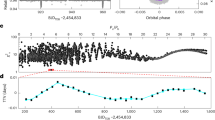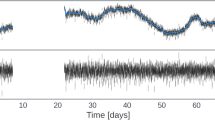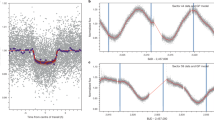Abstract
Few planetary systems have measured mutual inclinations, and even fewer are found to be non-coplanar. Observing the gravitational interactions between exoplanets is an effective tool to detect non-transiting companions to transiting planets. Evidence of these interactions can manifest in the light curve through transit timing variations (TTVs) and transit duration variations (TDVs). Here, through analysis of Kepler photometry and joint TTV–TDV modelling, we confirm the detection of KOI-134 b, a transiting planet with mass and size similar to Jupiter on a period of ~67 days, and find that it exhibits high TTVs (20-h amplitude) and significant TDVs. We explain these signals with the presence of an innermost non-transiting planet in 2:1 resonance with KOI-134 b. KOI-134 c has a mass \(M=0.22{0}_{-0.011}^{+0.010}{M}_{{\rm{Jup}}}\) and a moderately high mutual inclination with KOI-134 b of \({i}_{{\rm{mut}}}=15.{4}_{-2.5}^{+2.{8}^{\circ }}\). Moreover, the inclination variations of KOI-134 b are so large that the planet is predicted to stop transiting in about 100 years. This system architecture cannot be easily explained by any one formation mechanism, with other dynamical effects needed to excite the planets’ mutual inclination while still preserving their resonance.
This is a preview of subscription content, access via your institution
Access options
Access Nature and 54 other Nature Portfolio journals
Get Nature+, our best-value online-access subscription
27,99 € / 30 days
cancel any time
Subscribe to this journal
Receive 12 digital issues and online access to articles
118,99 € per year
only 9,92 € per issue
Buy this article
- Purchase on SpringerLink
- Instant access to full article PDF
Prices may be subject to local taxes which are calculated during checkout




Similar content being viewed by others
Data availability
The Kepler data used in this analysis can be accessed via the Kepler Data Search & Retrieval Tool (https://archive.stsci.edu/kepler/data_search/search.php). Any other datasets that were generated can be obtained from E.N. upon reasonable request.
Code availability
This study makes use of the following publicly available packages: astroARIADNE, batman, numpy, matplotlib, RadVel, REBOUND and scipy. The scripts used for this analysis are available via GitHub at https://github.com/enabbie/KOI134.
References
Rivera, E. J. et al. The Lick-Carnegie Exoplanet Survey: a Uranus-mass fourth planet for GJ 876 in an extrasolar Laplace configuration. Astrophys. J. 719, 890–899 (2010).
Sanchis-Ojeda, R. et al. Alignment of the stellar spin with the orbits of a three-planet system. Nature 487, 449–453 (2012).
Nesvorný, D. et al. The detection and characterization of a nontransiting planet by transit timing variations. Science 336, 1133–1136 (2012).
Huber, D. et al. Stellar spin–orbit misalignment in a multiplanet system. Science 342, 331–334 (2013).
Almenara, J. M. et al. Absolute masses and radii determination in multiplanetary systems without stellar models. Mon. Not. R. Astron. Soc. 453, 2644–2652 (2015).
Hamann, A., Montet, B. T., Fabrycky, D. C., Agol, E. & Kruse, E. K2-146: discovery of planet c, precise masses from transit timing, and observed precession. Astron. J. 158, 133 (2019).
Johnson, M. C. et al. An aligned orbit for the young planet V1298 tau b. Astron. J. 163, 247 (2022).
Feinstein, A. D. et al. H-alpha and Ca II infrared triplet variations during a transit of the 23 Myr planet V1298 tau c. Astron. J. 162, 213 (2021).
Goldreich, P. & Tremaine, S. Disk–satellite interactions. Astrophys. J. 241, 425–441 (1980).
Lissauer, J. J. et al. Architecture and dynamics of Kepler’s candidate multiple transiting planet systems. Astrophys. J. Suppl. Ser. 197, 8 (2011).
Steffen, J. H. et al. Five Kepler target stars that show multiple transiting exoplanet candidates. Astrophys. J. 725, 1226–1241 (2010).
Fang, J. & Margot, J.-L. Are planetary systems filled to capacity? A study based on Kepler results. Astrophys. J. 767, 115 (2013).
Fabrycky, D. C. et al. Architecture of Kepler’s multi-transiting systems. II. New investigations with twice as many candidates. Astrophys. J. 790, 146 (2014).
Marzari, F. & Weidenschilling, S. J. Eccentric extrasolar planets: the jumping Jupiter model. Icarus 156, 570–579 (2002).
Chatterjee, S., Ford, E. B., Matsumura, S. & Rasio, F. A. Dynamical outcomes of planet–planet scattering. Astrophys. J. 686, 580–602 (2008).
Jurić, M. & Tremaine, S. Dynamical origin of extrasolar planet eccentricity distribution. Astrophys. J. 686, 603–620 (2008).
Dawson, R. I. & Chiang, E. A class of warm Jupiters with mutually inclined, apsidally misaligned close friends. Science 346, 212–216 (2014).
McArthur, B. E. et al. New observational constraints on the υ Andromedae system with data from the Hubble Space Telescope and Hobby–Eberly Telescope. Astrophys. J. 715, 1203–1220 (2010).
Dawson, R. I. et al. Large eccentricity, low mutual inclination: the three-dimensional architecture of a hierarchical system of giant planets. Astrophys. J. 791, 89 (2014).
Mills, S. M. & Fabrycky, D. C. Kepler-108: a mutually inclined giant planet system. Astron. J. 153, 45 (2017).
Rein, H. & Liu, S.-F. REBOUND: an open-source multi-purpose N-body code for collisional dynamics. Astron. Astrophys. 537, A128 (2012).
Korth, J. et al. TOI-1130: a photodynamical analysis of a hot Jupiter in resonance with an inner low-mass planet. Astron. Astrophys. 675, A115 (2023).
Korth, J. et al. TOI-1408: discovery and photodynamical modeling of a small inner companion to a hot Jupiter revealed by transit timing variations. Astrophys. J. Lett. 971, L28 (2024).
Ricker, G. R. et al. Transiting Exoplanet Survey Satellite (TESS). J. Astron. Telesc. Instrum. Syst. 1, 014003 (2015).
Dawson, R. I. et al. TOI-216b and TOI-216 c: two warm, large exoplanets in or slightly wide of the 2:1 orbital resonance. Astron. J. 158, 65 (2019).
Dawson, R. I. et al. Precise transit and radial-velocity characterization of a resonant pair: the warm Jupiter TOI-216c and Eccentric Warm Neptune TOI-216b. Astron. J. 161, 161 (2021).
Nesvorný, D., Chrenko, O. & Flock, M. TOI-216: resonant constraints on planet migration. Astrophys. J. 925, 38 (2022).
Nesvorný, D. et al. KOI-142, the king of transit variations, is a pair of planets near the 2:1 resonance. Astrophys. J. 777, 3 (2013).
Lithwick, Y., Xie, J. & Wu, Y. Extracting planet mass and eccentricity from TTV data. Astrophys. J. 761, 122 (2012).
Deck, K. M., Payne, M. & Holman, M. J. First-order resonance overlap and the stability of close two-planet systems. Astrophys. J. 774, 129 (2013).
Murray, C. D. & Dermott, S. F. Solar System Dynamics (Cambridge Univ. Press, 1999).
Thommes, E. W. & Lissauer, J. J. Resonant inclination excitation of migrating giant planets. Astrophys. J. 597, 566–580 (2003).
Cresswell, P. & Nelson, R. P. Three-dimensional simulations of multiple protoplanets embedded in a protostellar disc. Astron. Astrophys. 482, 677–690 (2008).
Jenkins, J. M. et al. Overview of the Kepler Science Processing Pipeline. Astrophys. J. Lett. 713, L87 (2010).
Coughlin, J. L. et al. Planetary candidates observed by Kepler. VII. The first fully uniform catalog based on the entire 48-month data set (Q1–Q17 DR24). Astrophys. J. Suppl. Ser. 224, 12 (2016).
Borucki, W. J. et al. Characteristics of planetary candidates observed by Kepler. II. Analysis of the first four months of data. Astrophys. J. 736, 19 (2011).
Thompson, S. E. et al. Planetary candidates observed by Kepler. VIII. A fully automated catalog with measured completeness and reliability based on Data Release 25. Astrophys. J. Suppl. Ser. 235, 38 (2018).
Bryson, S. T. et al. in The Kepler Certified False Positive Table. Kepler Science Document KSCI-19093-003 (eds Haas, M. R. & Batalha, N. M.) 12 (Kepler Office at NASA Ames, 2017).
Vanderburg, A. et al. A habitable-zone Earth-sized planet rescued from false positive status. Astrophys. J. Lett. 893, L27 (2020).
Fűrész, G., Szentgyorgyi, A. H. & Meibom, S. Precision of radial velocity surveys using multiobject spectrographs—experiences with hectochelle. In Precision Spectroscopy in Astrophysics (eds Santos, N. C. et al.) 287–289 (Springer, 2008).
Zhou, G. et al. A well-aligned orbit for the 45 Myr-old transiting Neptune DS Tuc Ab. Astrophys. J. Lett. 892, L21 (2020).
Vogt, S. S. et al. HIRES: the high-resolution echelle spectrometer on the Keck 10-m telescope. In Proc. Society of Photo-Optical Instrumentation Engineers (SPIE) Conference Series Instrumentation in Astronomy VIII (eds Crawford, D. L. & Craine, E. R.) 362–375 (SPIE, 1994).
Tull, R. G., MacQueen, P., Sneden, C. & Lambert, D. L. The McDonald 2.7-in echelle spectrometer. In Proc. Astronomical Society of the Pacific Conference Series (eds Pyper, D. M. & Angione, R. J.) 148 (ASP, 1994).
Buchhave, L. A. et al. An abundance of small exoplanets around stars with a wide range of metallicities. Nature 486, 375–377 (2012).
Valenti, J. A. & Piskunov, N. Spectroscopy Made Easy: a new tool for fitting observations with synthetic spectra. Astron. Astrophys. Suppl. 118, 595–603 (1996).
Baranec, C. et al. Bringing the visible universe into focus with Robo-AO. J. Vis. Exp. 12, 50021 (2013).
Baranec, C. et al. High-efficiency autonomous laser adaptive optics. Astrophys. J. Lett. 790, L8 (2014).
Ziegler, C. et al. Robo-AO Kepler Planetary Candidate Survey. III. Adaptive optics imaging of 1629 Kepler exoplanet candidate host stars. Astron. J. 153, 66 (2017).
Tayar, J., Claytor, Z. R., Huber, D. & van Saders, J. A guide to realistic uncertainties on the fundamental properties of solar-type exoplanet host stars. Astrophys. J. 927, 31 (2022).
Eastman, J. D. et al. EXOFASTv2: a public, generalized, publication-quality exoplanet modeling code. Preprint at https://arxiv.org/abs/1907.09480 (2019).
Fulton, B. J., Petigura, E. A., Blunt, S. & Sinukoff, E. RadVel: the radial velocity modeling toolkit. Publ. Astron. Soc. Pac. 130, 044504 (2018).
Foreman-Mackey, D., Hogg, D. W., Lang, D. & Goodman, J. emcee: The MCMC Hammer. Publ. Astron. Soc. Pac. 125, 306 (2013).
Kreidberg, L. batman: BAsic Transit Model cAlculatioN in Python. Publ. Astron. Soc. Pac. 127, 1161 (2015).
Murphy, S. J. An examination of some characteristics of Kepler short- and long-cadence data. Mon. Not. R. Astron. Soc. 422, 665–671 (2012).
Choi, J. et al. Mesa Isochrones and Stellar Tracks (MIST). I. Solar-scaled models. Astrophys. J. 823, 102 (2016).
Green, G. M. dustmaps: a Python interface for maps of interstellar dust. J. Open Source Softw. 3, 695 (2018).
Schlegel, D. J., Finkbeiner, D. P. & Davis, M. Maps of dust infrared emission for use in estimation of reddening and cosmic microwave background radiation foregrounds. Astrophys. J. 500, 525–553 (1998).
Schlafly, E. F. & Finkbeiner, D. P. Measuring reddening with Sloan Digital Sky Survey stellar spectra and recalibrating SFD. Astrophys. J. 737, 103 (2011).
Kipping, D. M. Efficient, uninformative sampling of limb darkening coefficients for two-parameter laws. Mon. Not. R. Astron. Soc. 435, 2152–2160 (2013).
Seager, S. & Mallén-Ornelas, G. A unique solution of planet and star parameters from an extrasolar planet transit light curve. Astrophys. J. 585, 1038–1055 (2003).
Rein, H. & Spiegel, D. S. IAS15: a fast, adaptive, high-order integrator for gravitational dynamics, accurate to machine precision over a billion orbits. Mon. Not. R. Astron. Soc. 446, 1424–1437 (2015).
Kipping, D. M. Investigations of approximate expressions for the transit duration. Mon. Not. R. Astron. Soc. 407, 301–313 (2010).
Korth, J. Characterization of Extrasolar Multi-planet Systems by Transit Timing Variation. PhD thesis, Universität zu Köln (2020); https://kups.ub.uni-koeln.de/11289/
Nesvorný, D. & Vokrouhlický, D. Dynamics and transit variations of resonant exoplanets. Astrophys. J. 823, 72 (2016).
Lithwick, Y. & Wu, Y. Resonant repulsion of Kepler planet pairs. Astrophys. J. Lett. 756, L11 (2012).
Aarseth, S. J. Gravitational N-Body Simulations (Cambridge Univ. Press, 2003).
Faridani, T. H., Naoz, S., Li, G. & Inzunza, N. Let’s sweep: the effect of evolving J2 on the resonant structure of a three-planet system. Astrophys. J. 956, 90 (2023).
Faridani, T., Naoz, S., Li, G., Rice, M. & Inzunza, N. More likely than you think: inclination-driving secular resonances are common in known exoplanet systems. Astrophys. J. 978, 18 (2024).
Nagasawa, M., Lin, D. N. C. & Ida, S. Eccentricity evolution of extrasolar multiple planetary systems due to the depletion of nascent protostellar disks. Astrophys. J. 586, 1374–1393 (2003).
Petrovich, C., Muñoz, D. J., Kratter, K. M. & Malhotra, R. A disk-driven resonance as the origin of high inclinations of close-in planets. Astrophys. J. Lett. 902, L5 (2020).
Huang, C. X. et al. Photometry of 10 million stars from the first two years of TESS full frame images: part II. Res. Notes AAS 4, 206 (2020).
Kovács, G., Zucker, S. & Mazeh, T. A box-fitting algorithm in the search for periodic transits. Astron. Astrophys. 391, 369–377 (2002).
Hartman, J. VARTOOLS: Light Curve Analysis Program record ascl:1208.016 (Astrophysics Source Code Library, 2012).
Holczer, T. et al. Transit timing observations from Kepler. IX. Catalog of the full long-cadence data set. Astrophys. J. Suppl. Ser. 225, 9 (2016).
Acknowledgements
We thank R. Dawson for helpful discussions throughout our analysis. E.N. acknowledges the PhD scholarship provided by the ARC Discovery Project DP220100365. C.X.H. and A.V. thank the support of the ARC DECRA project DE200101840. A.V. thanks M. Omohundro, K. Deck, A. Vanderburg and J. Becker for helpful comments during the inception of this study. G.Z. thanks the support of the Australian Research Council project FT230100517. We acknowledge support from the Swiss NCCR PlanetS and the Swiss National Science Foundation. This work has been carried out within the framework of the NCCR PlanetS supported by the Swiss National Science Foundation under grant numbers 51NF40182901 and 51NF40205606. J.K. acknowledges support from the Swedish Research Council (project grants 2017-04945 and 2022-04043) and of the Swiss National Science Foundation under grant number TMSGI2_211697. H.P. acknowledges support by the Spanish Ministry of Science and Innovation with the Ramon y Cajal fellowship number RYC2021-031798-I. Funding from the University of La Laguna and the Spanish Ministry of Universities is acknowledged.
Author information
Authors and Affiliations
Contributions
E.N. led the light curve and N-body analyses, interpretation of the results and preparation of the paper. C.X.H. supervised the project, conducted N-body simulations, facilitated analysis of the system’s TDVs and contributed to the writing of the paper. J.K. and H.P. performed the photodynamical analyses. S.W. conducted disk migration simulations to investigate the system’s formation and evolution. A.V. identified the system and contributed to the analysis of the Kepler observations and mid-transit times. R.W. supervised the project and contributed to the analysis. G.L. contributed to the theoretical dynamical analyses. D.N.C.L. contributed to analysis and interpretation of disk migration simulations. A.B., D.W.L. and G.Z. were responsible for the TRES radial velocity observations and data reduction.
Corresponding author
Ethics declarations
Competing interests
The authors declare no competing interests.
Peer review
Peer review information
Nature Astronomy thanks Daniel Fabrycky, Melissa Hobson and Michael Ireland for their contribution to the peer review of this work.
Additional information
Publisher’s note Springer Nature remains neutral with regard to jurisdictional claims in published maps and institutional affiliations.
Extended data
Extended Data Fig. 1 Direct imaging observations of KOI-134.
Panel (a): 5σ sensitivity curve depicting the difference in magnitude versus orbital separation. Panel (b): High resolution i-band direct imaging of KOI-134 observed with the P60 telescope’s Robo-AO instrument. The 8" square image cutout is centered on the star, with a pixel scale of 0.021" per pixel.
Extended Data Fig. 2 KOI-134 b in context with other Kepler TTV systems.
The histogram shows the distribution of TTV amplitudes from Kepler systems with significant TTVs, taken from Table 5 of the Kepler TTV catalog by74. The dashed line shows the position of KOI-134 b in comparison to this population.
Extended Data Fig. 3 The proximity of KOI-134 to an exact 2:1 resonance.
The position of KOI-134 within the 2:1 resonant ___domain, re-parametrized to a 1-degree of freedom model30. Randomly-sampled points from the planet parameter posterior distribution are shown in red circles. X measures the system’s separatrices and stable/unstable fixed points, and γ quantifies how close the system is to an exact resonance. The shaded region denotes the formally-defined resonant ___domain.
Extended Data Fig. 4 Trajectories of the resonant angles of KOI-134 b and c.
Trajectories of the resonant angles (Θe,b and Θe,c) and the secular apsidal angle Δω, as they evolve over a time scale of 1 million years. Panel (a) shows these trajectories for KOI-134 b, while panel (b) shows those for KOI-134 c. The color scheme is shared with Fig. 4.
Extended Data Fig. 5 The population of near-MMR multi-planet systems with giant planets.
Confirmed multi-planet systems with a giant planet, where at least one pair of orbital periods are near a first-order resonance. The empty circles represent non-transiting planets. Marker size corresponds to relative planet radius.
Supplementary information
Supplementary Information
Supplementary text, Figs. 1–4, Tables 1–3 and references.
Rights and permissions
Springer Nature or its licensor (e.g. a society or other partner) holds exclusive rights to this article under a publishing agreement with the author(s) or other rightsholder(s); author self-archiving of the accepted manuscript version of this article is solely governed by the terms of such publishing agreement and applicable law.
About this article
Cite this article
Nabbie, E., Huang, C.X., Korth, J. et al. A high mutual inclination system around KOI-134 revealed by transit timing variations. Nat Astron (2025). https://doi.org/10.1038/s41550-025-02594-8
Received:
Accepted:
Published:
DOI: https://doi.org/10.1038/s41550-025-02594-8



